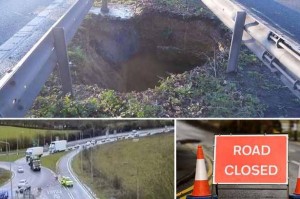A spate of sinkholes popping up around the UK has shocked communities and ravaged people’s homes and cars.
A house is close to collapse after a 25ft sinkhole emerged in North Yorkshire on Monday.
And a woman is fighting for her life in South Wales, after an apparent sinkhole swallowed her car.
In the past month alone, a 15ft hole opened up on the M2, homes were evacuated in Hemel Hempstead due to a 35ft hole and a 30ft crater engulfed a car in High Wycombe.
But why are they appearing and where have they come from? We have all you need to know here.
What are sinkholes?
Any collapsed bowl-shaped hole that forms under the ground draining liquid from everything around it, is a sink hole.
Sinkholes appear when water wears down on soluble bedrock.
This is called the Karst process where rock such as limestone or chalk is destroyed by acidic water.
Sinkholes tend to appear next to buildings and other human constructions where the water is more concentrated. For example, when water drains off a roof.
They’re essentially a hole in the ground which has been eroded by water.
Where are they appearing?
Some 17 homes had to be evacuated when a 35ft wide sinkhole appeared under a quiet cul-de-sac in Hemel Hempstead.
Three days later part of a house in Ripon, North Yorkshire, was swallowed by a 25ft-wide sinkhole, leaving the building likely to collapse.
The same day, a sinkhole pattern formed a trail of giant footsteps across the Garden of England near the M2 crater in Kent.
And on February 20, a woman was left fighting for her life after her car was crushed in an apparent sink hole near to Swansea, although police later denied it.
But it’s not just the UK – these unsuspecting victims were caught on camera as the ground dramatically gave way beneath them.
So what’s causing the spate of sinkholes?
Weather, climate change and human activity are thought to be some of the causes of the holes.
South East has suffered from the most sinkholes of late, not just because of the wet weather but also due to most of the ground being made of chalk.
Other danger zones for sinkholes are Mendips near Bristol, the Peak District, the Yorkshire Dales and areas of Wales.
Ripon, where a sinkhole has recently emerged, is becoming known as the sinkhole capital of the UK because of gypsum (chalk) deposits.
Areas of Cheshire are at risk too due to its salt deposits.
Are they dangerous?
Yes and no.
The type in this country are not as terrible as they look, but that’s not to say the sudden appearance of such holes can’t cause dangerous situations.
Some sinkholes can just cause the ground to sag but others can have a catastrophic effect.
The deepest sinkhole is believed to be the one in Xiaozhai tiankeng in China.
This ‘heavenly pit’ as locals call it, is 662m deep and 626m wide.
What are the different types?
Two different types of sink holes can appear.
A cover-collapse sinkhole opens-up quickly whereas a cover-subsidence sinkhole is created over a long period of time.
The former type, cover-collapse is what’s been making the headlines recently.
Small cracks and voids form out-of-sight and are hollowed out by water. Then, as the hole expands when it can no longer support its own wait it will suddenly collapse, revealing the crater underneath.
Cover-subsidence is when the ground is worn down over a period of time and then eventually, the hole creates a pond-like feature as the ground erodes and is filled with water.
Are more on the way?
Experts warn that more sinkholes could be on the way due to climate change.
This is due to drier summers and wetter winters.
Dr Vanessa Banks says in the British Geological Survey, that now is a testing time.
She said: “The ground is saturated at the moment, in certain parts of the country, and where it’s saturated, it will remain saturated for some weeks, if not months.
“And gradually the situation will improve, but in the short term I suspect there will be more of these incidents being reported.”
Whilst rainwater can trigger sinkholes, all of the cases in the past month have been in areas of chalkland.
If it was just due to the rain, you would expect to see some in Somerset which has been the hardest hit by the floods.





